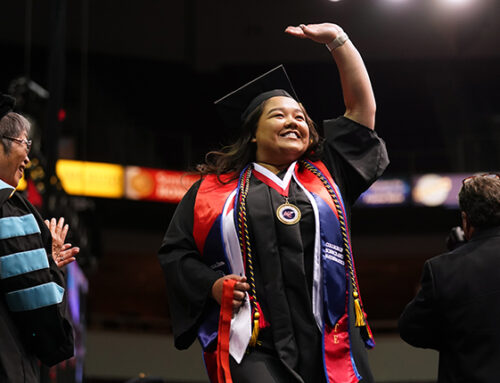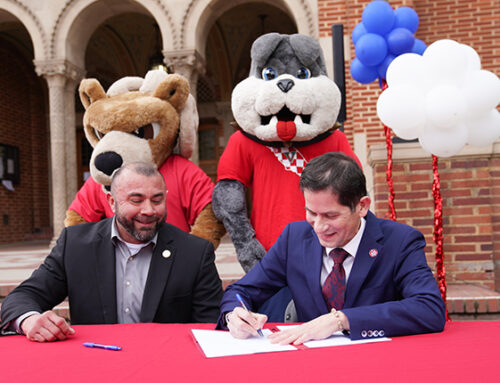A California State University report released today on equal opportunity in athletics for women shows continued overall increases in the level of female participants, funding for women’s intercollegiate athletic programs, and an increase in grants-in-aid. The latest figures are for the 2006-07 academic year, and are part of a voluntary self-monitoring report conducted annually by the CSU.
In 1993, the CSU and the California National Organization for Women (CA NOW) entered into a consent decree on gender equity in women’s athletics. Under the agreement, the CSU compiled annual reports on progress in participation rates, funding and grants for women’s athletics on its NCAA-member campuses. The final report under the consent decree was for 1998-1999, but the CSU has continued to issue the self-monitoring report on a voluntary basis.
At the CSU systemwide level, the number of female participants in intercollegiate athletics has increased from 1,862 in 1992-93 to 3,999 in 2006-07, on the 20 NCAA member campuses, an increase of 114.8 percent over the past 14 years. During the previous year, 159 more females participated in intercollegiate athletics, a one-year increase of 4.1 percent.
In 1992, there was an 18.5 percent difference between the number of female undergraduates enrolled (53.2 percent) and female student athlete participation (34.7 percent) in the CSU system. As of fall 2006, this difference has been decreased to 1.4 percent (57.1 percent enrollment and 55.7 percent participation).
“The California State University campuses have demonstrated their continuing commitment to gender equity in athletics, which is evident by the number of campuses in full compliance,” said CSU Chancellor Charles B. Reed. “We believe our self-monitoring efforts and voluntary annual report keep us moving forward and provide a way to publicly assess progress. The CSU is one of the leading university systems in the U.S. in providing opportunities for female athletes.”
Systemwide, the CSU female undergraduate enrollment increased from 147,566 students in 1992-93 to 196,764 in 2006-07. This reflects a 33 percent increase in the number of female undergraduate students enrolled as compared to a 14 percent increase in male undergraduate students during that same time period. This rise in female enrollment results in campuses increasing female student athlete participation, expenditures and grants-in-aid at a faster pace.
Overall, CSU expenditures for women’s athletics increased from $11.2 million in 1992-93 to $83.3 million in 2006-07. The total increase over the previous year was $7 million, a 9.2 percent increase. Funds allocated for grants-in-aid for female athletes increased from $2.5 million in 1992-93 to $13.2 million in 2006-07. The increase in grants-in-aid over the past year was just over $1 million, for an 8.5 percent increase.
“We continue to monitor these areas at all of our campuses on a voluntary basis to ensure that campuses are moving in the right direction toward full compliance,” said Fresno State President John Welty, who chairs the system gender equity committee. CSU campuses that do not meet their target goals for two consecutive years are required to submit a plan to the Office of the Chancellor outlining what actions it will take to meet its target goals in the future.
Under the original agreement which sought equity in participation, funds and grants, each campus would ensure:
· Participation by men and women athletes will be within five percentage points of the proportion of NCAA eligible women and men undergraduates on that campus;
· Expenditures will be within 10 percentage points of the proportion of NCAA eligible women and men undergraduates, with the deduction of non-comparable expenses for two men’s and two women’s sports; and Grants-in-aid will be within five percentage points of the proportion of NCAA eligible women and men undergraduates
For 2006-07, 13 campuses met their target goals in all three areas including: Bakersfield, Chico, East Bay, Fullerton, Humboldt, Los Angeles, Northridge, Pomona, Sacramento, San Francisco, San Jose, San Luis Obispo and Stanislaus.
PARTICIPATION
During 2006-07, 16 of the 20 NCAA-member campuses met or exceeded their target goals in participation including: Bakersfield, Chico, East Bay, Fresno, Fullerton, Humboldt, Los Angeles, Northridge, Pomona, Sacramento, San Diego, San Francisco, San Jose, San Luis Obispo, Sonoma, Stanislaus.
The campuses not in compliance and the percentage by which they missed the goal are: Dominguez Hills, 1.5; Long Beach, .8; Monterey Bay, 2.0; and San Bernardino, 3.4.
FUNDING
Eighteen campuses met or exceeded their targets goals in expenditures including: Bakersfield, Chico, East Bay, Fresno, Fullerton, Humboldt, Long Beach, Los Angeles, Monterey Bay, Northridge, Pomona, Sacramento, San Bernardino, San Diego, San Francisco, San Jose, San Luis Obispo and Stanislaus.
Two campuses were less than two percent from compliance: Dominguez Hills, 1.7 and Sonoma, .8.
GRANTS
Seventeen campuses met or exceeded their target goals in grants-in-aid including: Bakersfield, Chico, East Bay, Fullerton, Humboldt, Long Beach, Los Angeles, Monterey Bay, Northridge, Pomona, Sacramento, San Bernardino, San Francisco, San Jose, San Luis Obispo, Sonoma and Stanislaus.
Three campuses did not meet their target goals including Dominguez Hills, 2.9, Fresno, 8.0 and San Diego, 6.8.


